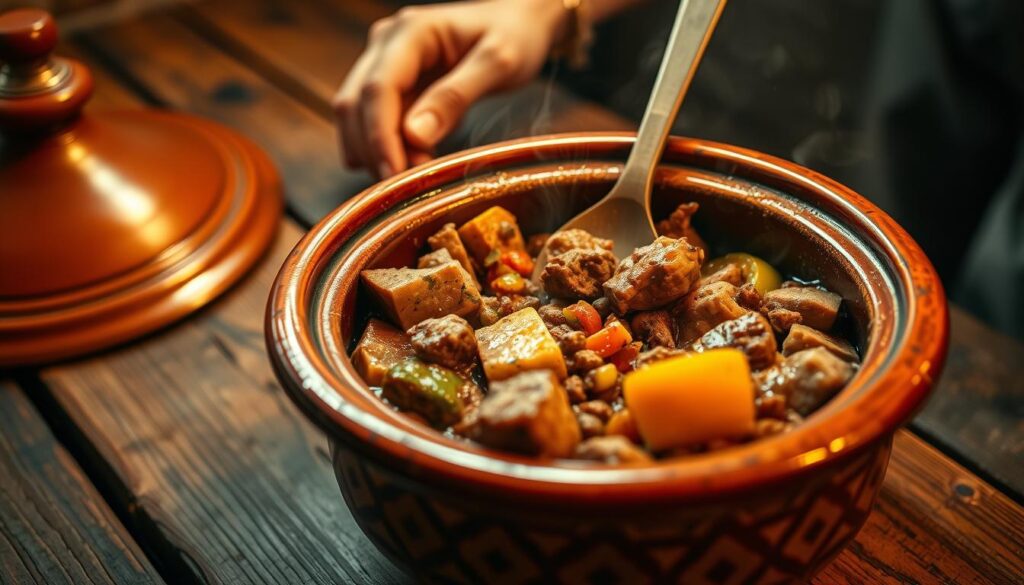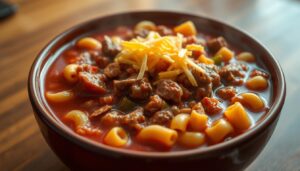The Moroccan Tajine is more than just a dish; it’s a culinary experience deeply rooted in the culture and traditions of Morocco. This slow-cooked masterpiece is a staple of Moroccan cuisine, known for its rich flavors and aromas.
In this article, we’ll take you on a journey through the world of traditional cooking, exploring the significance of Tajine in Moroccan culture and the art of preparing it. From the choice of ingredients to the slow cooking process, we’ll delve into the details that make this dish a beloved favorite around the world.
Key Takeaways
- Understanding the cultural significance of Tajine in Moroccan cuisine.
- Learning the basics of traditional Moroccan cooking techniques.
- Exploring the ingredients and spices that make Tajine unique.
- Mastering the art of slow cooking for rich flavors.
- Discovering variations of Tajine recipes for diverse tastes.
The Rich Heritage of Moroccan Tajine
In the heart of Moroccan cuisine lies the Tajine, a dish with a rich heritage. This traditional North African dish has been a cornerstone of Moroccan cooking for centuries, reflecting the country’s diverse cultural influences.
Origins and Cultural Significance
The Tajine’s origins date back to the Berber tribes, who used clay pots with conical lids to cook a variety of dishes. Over time, the Tajine became an integral part of Moroccan culture, symbolizing hospitality and community. The dish is often served on special occasions, such as weddings and holidays, highlighting its cultural significance.
The Tajine’s cultural importance extends beyond the kitchen, representing a connection to Morocco’s rich history and traditions. The slow-cooked stew is a testament to the country’s culinary diversity, shaped by African, Arab, and Mediterranean influences.
Evolution of Tajine Cooking Through Centuries
Tajine cooking has evolved significantly over the centuries, adapting to various cultural and culinary traditions. The dish has been influenced by the influx of different cultures, including the Arabs, who introduced new spices and cooking techniques.
The evolution of Tajine cooking is also reflected in the variety of ingredients used. From the use of preserved lemons and olives to the incorporation of meats and vegetables, the dish has become a melting pot of flavors. The table below highlights some of the key ingredients used in different Tajine recipes:
| Ingredient | Traditional Use | Modern Adaptation |
|---|---|---|
| Preserved Lemons | Used for their salty, tangy flavor | Still used, but with a focus on quality |
| Olive Oil | Used for cooking and flavor | Used in various forms, including infused oils |
| Meat and Vegetables | Used in a variety of combinations | Still used, with a focus on freshness and seasonality |
The Tajine’s evolution is a testament to the dynamic nature of Moroccan cuisine, shaped by historical and cultural factors. Today, the Tajine remains a beloved dish, with its rich flavors and aromas continuing to captivate palates around the world.
Understanding the Tajine Cookware
At the heart of every authentic Tajine dish is the Tajine pot itself, a piece of cookware steeped in history and functionality. The unique design of the Tajine pot is not just aesthetically pleasing; it plays a crucial role in the cooking process, allowing for the slow cooking that is characteristic of Tajine dishes.
Anatomy of a Traditional Tajine Pot
A traditional Tajine pot is made up of two main parts: the base and the conical lid. The base is typically wide and shallow, providing a large surface area for the ingredients to cook. The conical lid is designed to allow the steam to rise, condense, and then drop back into the dish, creating a cycle that ensures the ingredients are cooked evenly and infused with flavors. This design is crucial for the slow cooking technique that Tajine cooking is known for.
Clay vs. Ceramic vs. Modern Adaptations
Tajine pots are made from various materials, including clay, ceramic, and modern adaptations like cast iron or stainless steel. Clay Tajines are traditional and provide excellent heat distribution, but they require more care. Ceramic Tajines are durable and easy to clean, making them a popular choice for home cooks. Modern adaptations offer versatility and can be used on various cooktops, including induction.
Seasoning and Caring for Your Tajine
To ensure the longevity of your Tajine pot, proper care is essential. For clay and ceramic Tajines, seasoning before the first use is recommended. This involves applying a layer of oil and heating it to create a non-stick surface. Regular cleaning with mild soap and water, and avoiding abrasive materials, will help maintain your Tajine. For modern Tajines, following the manufacturer’s instructions is key to preserving the cookware.
Understanding and caring for your Tajine cookware is fundamental to mastering the art of Tajine cooking. With the right pot and proper care, you can enjoy authentic Moroccan Tajine dishes for years to come.
Essential Ingredients for Authentic Tajine Dishes
Authentic Tajine dishes are characterized by their rich and complex flavors, achieved through the use of traditional ingredients. The essence of Tajine cooking lies in the careful selection of spices, herbs, proteins, vegetables, and fruits, which are combined in a way that creates a harmonious balance of flavors.
Foundational Spices and Herbs
The foundation of Tajine’s distinctive flavor profile is built upon a blend of aromatic spices and fresh herbs. Spices such as cumin, coriander, cinnamon, and ginger are staples in Tajine cooking, providing warmth and depth to the dish. Herbs like parsley, cilantro, and mint add freshness and complexity. The combination and proportion of these spices and herbs can vary depending on the specific Tajine recipe, but they are essential to creating the authentic taste of Moroccan cuisine.
As noted by Moroccan culinary experts, « The art of blending spices is a skill passed down through generations, and it’s what sets Tajine apart from other dishes. » The careful balance of spices and herbs is crucial for achieving the characteristic flavor of Tajine.
Proteins, Vegetables, and Fruits Commonly Used
Tajine recipes often feature a variety of proteins, including lamb, chicken, beef, and fish, which are slow-cooked to tender perfection. Vegetables such as onions, carrots, and potatoes are commonly used, adding texture and flavor to the dish. Fruits like prunes, apricots, and preserved lemons are also integral to many Tajine recipes, providing a sweet and tangy contrast to the savory elements.
The versatility of Tajine cooking allows for a wide range of ingredients to be used, making it a versatile and flavorful cuisine that can be adapted to various tastes and dietary preferences. Whether you’re preparing a traditional lamb Tajine or a vegetarian version, the key to success lies in the quality of the ingredients and the balance of flavors achieved through careful preparation and cooking.
The Art of Tajine: Cooking Techniques and Methods
The art of cooking Tajine is a nuanced process that involves specific techniques to achieve its signature flavors. Mastering these techniques is essential for anyone looking to delve into the world of Moroccan cuisine.
Proper Layering of Ingredients
One of the critical steps in preparing a Tajine is the proper layering of ingredients. This technique ensures that flavors are evenly distributed and that each component of the dish is cooked to perfection. Start by placing a layer of aromatics, such as onions and garlic, at the bottom of the Tajine pot. Next, add your choice of protein, followed by vegetables and finally any fruits or additional spices. This layering not only enhances the flavor but also aids in the slow cooking process, which is characteristic of Tajine cooking.

Temperature Control and Slow Cooking
Slow cooking is the heart of Tajine’s cooking technique, allowing the various ingredients to meld together and intensify in flavor. To achieve this, it’s crucial to control the temperature effectively. Traditionally, Tajine is cooked over low heat, either on a stovetop or in a clay oven. The key is to maintain a gentle simmer, ensuring that the ingredients cook slowly and absorb the aromatic spices. As René Char once said,
« The only way to do great work is to love what you do. »
In Tajine cooking, loving what you do means being patient and attentive to the cooking process.
Troubleshooting Common Cooking Issues
Despite the best preparations, issues can arise during Tajine cooking. Common problems include uneven cooking, where some ingredients are undercooked while others are overcooked, and flavor imbalance, where the dish may be too salty or too bland. To address these issues, it’s essential to monitor the cooking process closely and adjust the seasoning and heat as needed. For instance, if the Tajine is cooking too quickly, reducing the heat or adding a small amount of liquid can help. By being aware of these potential issues and knowing how to troubleshoot them, cooks can ensure a successful and delicious Tajine.
By mastering the art of Tajine cooking, including proper layering, temperature control, and troubleshooting, home cooks can create authentic Moroccan dishes that are rich in flavor and history. Whether you’re a seasoned chef or a culinary novice, the techniques involved in Tajine cooking offer a rewarding culinary journey.
Classic Meat Tajine Recipes
Meat Tajine recipes are a testament to the rich culinary heritage of Morocco, blending spices, herbs, and slow-cooking techniques. These traditional dishes have been perfected over centuries, offering a depth of flavor that is both complex and aromatic.
Lamb Tajine with Prunes and Almonds
Lamb Tajine with prunes and almonds is a classic Moroccan dish that beautifully balances the tender flavor of lamb with the sweetness of prunes and the crunch of almonds. To prepare this dish, start by browning the lamb in a mixture of olive oil and butter, then add a blend of spices including cumin, coriander, and cinnamon. The prunes and almonds are added towards the end of the cooking process, allowing their flavors to meld with the lamb.
The result is a rich, flavorful Tajine that is both comforting and exotic. Serve with couscous or crusty bread to soak up the juices.
Chicken Tajine with Preserved Lemons and Olives
Chicken Tajine with preserved lemons and olives is another beloved recipe that showcases the unique flavors of Moroccan cuisine. The preserved lemons add a tangy, salty flavor, while the olives provide a brininess that complements the chicken perfectly. To make this dish, start by sautéing onions and garlic, then add the chicken and a blend of spices. Preserved lemons and olives are added later, allowing their flavors to infuse into the chicken.
This Tajine is a great example of how simple ingredients can be transformed into a complex and delicious meal. The combination of flavors is both refreshing and savory, making it a great option for a weeknight dinner.
Beef Tajine with Caramelized Onions and Raisins
Beef Tajine with caramelized onions and raisins is a hearty and comforting dish that is perfect for special occasions. The slow-cooked beef is tender and flavorful, while the caramelized onions and raisins add a sweet and savory element. To prepare this Tajine, start by browning the beef in oil, then add sliced onions and a blend of spices. The dish is slow-cooked until the beef is tender and the onions are caramelized.
The addition of raisins towards the end of cooking adds a burst of sweetness, balancing out the savory flavors of the beef and onions. This Tajine is a true representation of Moroccan cuisine’s ability to blend flavors and textures into a harmonious dish.
Vegetarian and Seafood Tajine Variations
The versatility of Tajine is showcased in its vegetarian and seafood variations, offering something for every palate. While traditional Tajine recipes often feature meat, the cooking method lends itself beautifully to a wide range of ingredients.
Seven-Vegetable Tajine
A Seven-Vegetable Tajine is a colorful and nutritious option, featuring a variety of vegetables such as carrots, zucchini, and bell peppers. This dish is not only visually appealing but also packed with flavor, as the slow-cooking process allows the vegetables to absorb the aromatic spices.
The beauty of this recipe lies in its flexibility; you can choose your favorite vegetables or use what’s seasonally available. The key is to layer the ingredients properly and let the Tajine work its magic.
Fish Tajine with Chermoula
For seafood lovers, a Fish Tajine with Chermoula is a delightful option. Chermoula, a traditional Moroccan herb sauce, adds a fresh and tangy flavor to the fish, which is cooked to perfection in the Tajine.
This recipe typically includes firm white fish, which holds up well to the slow-cooking process. The Chermoula sauce, made with parsley, cilantro, garlic, and lemon juice, infuses the fish with a burst of flavor, making it a standout dish.
Egg Tajine with Tomatoes and Peppers
An Egg Tajine with Tomatoes and Peppers is a simple yet satisfying recipe. This dish is perfect for a weeknight dinner, as it’s quick to prepare and cooks relatively fast.
The eggs are gently poached in a rich tomato and pepper sauce, flavored with a blend of spices. The result is a hearty and comforting meal that’s sure to become a favorite.
In conclusion, Tajine cooking is incredibly versatile, allowing for a wide range of vegetarian and seafood variations. Whether you’re in the mood for a colorful vegetable Tajine, a flavorful fish dish, or a hearty egg Tajine, there’s a recipe to suit every taste and preference.
Regional Tajine Specialties Across Morocco
From the coastal regions to the desert, Moroccan Tajine recipes showcase a remarkable diversity. The country’s varied cultural and geographical landscapes have significantly influenced the traditional cooking methods and ingredients used in Tajine preparation.
Northern Coastal Variations
The northern coastal regions of Morocco have been influenced by their proximity to the Mediterranean Sea and European cuisines. Tajine recipes in these areas often incorporate fresh seafood, such as fish and shrimp, and may include ingredients like preserved lemons and olives. The use of these ingredients reflects the cultural exchange and the availability of fresh produce in coastal areas.
- Seafood Tajine with chermoula sauce
- Tajine with mixed fish and vegetables
- Shrimp and chorizo Tajine
Central Mountain Styles
In the central mountainous regions, Tajine recipes tend to be heartier and more comforting, reflecting the colder climate and the need for nourishing meals. These Tajines often feature lamb or beef, cooked with a variety of vegetables and sometimes fruits like prunes or apricots. The slow-cooked nature of Tajine is particularly suited to the mountainous regions where cooking facilities can be basic.
- Lamb Tajine with prunes and almonds
- Beef Tajine with carrots and potatoes
Southern Desert Adaptations
The southern desert regions of Morocco have adapted Tajine cooking to the local ingredients available in the desert environment. Dates, figs, and other dried fruits are commonly used, along with meats like camel or goat. The harsh desert climate has also influenced the spices used, with a preference for warming spices like cumin, coriander, and cinnamon.
- Camel Tajine with dates and spices
- Vegetable Tajine with preserved lemons
The diversity in Tajine recipes across Morocco is a testament to the country’s rich cultural heritage and its ability to adapt traditional cooking methods to local ingredients and environments.
Modern Twists on Traditional Tajine Cooking
Modern kitchens are redefining Tajine cooking with fresh ingredients and innovative techniques, while honoring its rich heritage. This blend of old and new is giving rise to exciting variations that cater to contemporary tastes without losing the essence of traditional Tajine.
Fusion Tajine Recipes for American Palates
Adapting Tajine recipes to suit American tastes involves incorporating local ingredients and flavors while maintaining the core principles of Tajine cooking. For instance, using locally sourced vegetables and proteins, and adding a twist with American spices or herbs, can create a unique fusion.
Some ideas for fusion Tajine recipes include using buffalo chicken with a blend of Moroccan and American spices, or creating a vegetarian Tajine with roasted sweet potatoes and kale. The key is to balance flavors and textures, ensuring that the dish remains hearty and aromatic.

Adapting Tajine Techniques for Modern Kitchens
Applying traditional Tajine cooking techniques in modern kitchen settings requires some adjustments. Modern cookware and appliances, such as slow cookers or Instant Pots, can be used to achieve similar results to the traditional clay Tajine pot.
For example, layering ingredients and using the right spices remains crucial, but the cooking time and temperature can be adjusted according to the appliance used. This adaptation makes Tajine cooking more accessible and convenient for home cooks.
| Traditional Technique | Modern Adaptation | Benefit |
|---|---|---|
| Clay Tajine Pot | Slow Cooker or Instant Pot | Easier to use, less monitoring required |
| Layering Ingredients | Using modern cookware for layering | Retains flavor, adaptable to different cookware |
| Slow Cooking | Adjusting cooking time with modern appliances | More convenient, faster cooking options available |
From Morocco to Your Table: Serving and Enjoying Tajine
Serving Tajine is an art that brings people together, fostering a sense of community and warmth. Traditionally, Tajine is served directly from the clay pot, placed at the center of the table, allowing everyone to gather around and share in the meal. This communal aspect of dining is a cornerstone of Moroccan culture, emphasizing the importance of sharing flavorful cuisine with others.
To enhance the dining experience, consider pairing your Tajine with complementary sides and beverages. Crusty bread, couscous, or a fresh salad can accompany the rich flavors of the Tajine. For beverages, a glass of mint tea, a traditional Moroccan drink, or a dry red wine can elevate the meal. Enjoying Tajine is not just about the taste; it’s about creating a warm and inviting atmosphere that makes every meal feel special.
When serving Tajine, the right tableware can add to the authenticity of the experience. Using colorful ceramics or traditional Moroccan dishes can transport your dining area to the vibrant markets of Marrakech. As you enjoy your Tajine, remember that the joy of cooking and sharing meals is a universal language, connecting people across cultures and borders.




